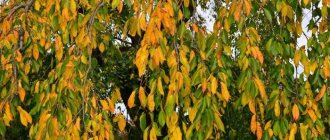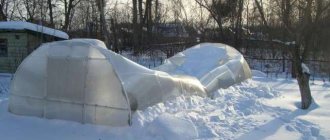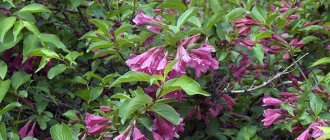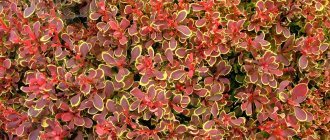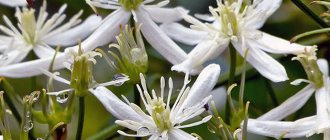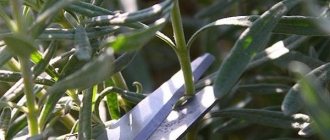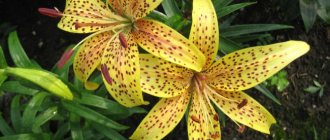Frost-resistant varieties
In Russia, wild weigela is found in Primorye. Three varieties of this deciduous shrub grow there: pleasant weigela, middendorf weigela and early weigela. Twice a year the shrub is covered with funnel-shaped flowers of various shades. At the same time, the shade of the petals gradually changes, becoming darker.
Important! All varieties of weigela require shelter for successful wintering. In regions with snowy winters, snow is used as additional protection and thrown on top of the bushes.
Species with the greatest frost resistance
For residents of Russia, especially in the northern regions, one of the defining characteristics of weigela is frost resistance. Therefore, it is preferable to choose the following types of weigela:
| Species name | Description | Frost resistance |
| Weigel Middendorf | A shrub up to 1.5 m tall, it blooms twice a year with yellow flowers in the form of inverted funnels. The flowering period lasts 30 days | up to -15 degrees |
| Weigela japonica | The height of the bushes is 1 m. During flowering, it is covered with funnel-shaped flowers up to 3 cm long, carmine in color. | up to -15 degrees |
| Weigela is nice | The length of the shoots is up to 1.3 m. During flowering, which occurs twice per season, funnel-shaped flowers of burgundy color with a light pink inside bloom on the branches | Tolerates frosts well |
| Weigela early | The bushes grow up to 1.5 m tall. During flowering, they are covered with beautiful flowers, pink on the outside and burgundy on the inside. Flowering lasts 1 month | up to -15 degrees |
| Veigel Maksimovich | The height of the shoots is 1.5 m. Light yellow, bell-shaped flowers appear in mid-May. Flowering lasts 1 month | up to -10 degrees |
Popular varieties
Weigela is distinguished by a variety of varieties, but those that have good resistance to frost are more suitable for the Russian climate. The following varieties are especially popular among domestic gardeners:
- The Pink Princess variety is easy to care for and has good endurance. In the south of Russia, in regions with a mild climate, it can be grown without insulation for the winter.
- The Purpurnaya variety forms bushes 1.5 m tall. Flowering occurs in mid-summer. At this time, the bush is covered with beet-colored flowers with a creamy core. It has good frost resistance, but in the northern regions it needs to be closed.
- The Alba variety forms bushes up to 3 m in height. It blooms with white flowers, gradually changing color to pink. Differs in average resistance to frosts.
- The Nana Variegata variety grows up to 1.5 m in height and is distinguished by unusual decorative leaves with a light edge. Flowering occurs in the second half of May. Frost resistance is up to -12 degrees. Therefore, shelter is required in the northern regions.
Comments
Write a comment
- Landscape Elements of landscape design DIY flowerpots
- Construction of a rock garden
- Garden paths
- Lighting and backlighting
- Garden sculpture
- Dry stream
- Alpine slide
- Flower beds and flower beds
- Flower pots
- Garden figures
- Hedges
- Lawn at the dacha
- Site drainage
- Decorative waterfall
- Playground
- lucky baking
- Plant varieties Flowers Rosary
- Exhibitions and events
- Feedback
Many gardeners in Russia prefer to plant deciduous ornamental shrubs in their summer cottages, which add zest to the entire appearance - this is weigela . Planting and caring for this shrub does not require much physical effort or time.
However, like any plant, this decorative beauty should also be cared for according to rules that you should consider carefully and determine for yourself whether you can cope with the task.
General Tips
Growing this plant in the garden is not difficult. To prepare weigela for winter, caring for it in the fall consists of performing the following mandatory activities:
- glaze;
- applying fertilizers with a high concentration of potassium;
- mulching the tree trunk circle;
- formative pruning;
- insulation in the fall using a frame or frameless method.
Feeding weigela in autumn
An adequate supply of nutrients will allow you to survive a long, cold winter. To fertilize shrubs before winter, it is best to use store-bought or home-prepared fertilizers with a high potassium content. To prepare fertilizer at home, mix 4 kg. rotted manure or compost, 50 g of superphosphate, 30 g of potassium sulfate (this amount is enough to enrich 1 square meter of plantings). You can also feed the bush with wood ash: per 1 sq. m. add 200 g of powder.
Autumn pruning of weigela
Shearing is a mandatory procedure for all varieties of deciduous crops. If pruning is carried out on time, the wounds on the shoots will soon heal, and the bush will acquire aesthetic appeal. Cutting off unnecessary shoots increases resistance to winter cold.
You need to trim weigela to solve the following problems:
- stimulating the growth of young shoots;
- giving the correct crown shape to adult plants;
- abundant flowering next year;
- rejuvenation;
- improving resistance against diseases.
You may be interested in:
Pruning honeysuckle: when and how to do it correctly, features, schemes Summer residents plant honeysuckle in their plots because it is unpretentious and easy to look after. Amateur flower growers…Read more…
Trim time
Removal of branches for sanitary purposes from shrubs is carried out in the spring. During this procedure, all diseased, broken or frost-damaged branches are cut out. In autumn, formative and rejuvenating pruning is carried out. The purpose of this procedure is to give the crown of the bush an aesthetic appearance and, if necessary, remove old shoots that no longer produce flowers.
When it is not possible to prune the plant twice a year, it is preferable to carry out the autumn procedure. For weigela it is of greater importance. In the spring, only a few branches are removed, which are not of great importance for the development of the bush.
Important!
They begin to trim the shrub in the fall immediately after the end of re-blooming. It usually ends in September or until mid-October.
Pruning technique
Before you begin to remove all unnecessary branches, the soil in the circle around the trunk and the lower part of the plant are sprayed with a solution of any fungicide. This will protect the bush from infection with fungal diseases. Then trim according to the following instructions:
- Cut all affected, broken branches 0.5 cm above the second healthy bud.
- Cut off poorly developing branches completely.
- Remove a third of the old branches to rejuvenate the bush and stimulate flowering.
- Thin out the shoots directed deeper into the bush to reduce crowding.
- Shorten the branches protruding from the general crown and completely remove the fallen ones to improve their decorative qualities.
If pruning is carried out for rejuvenating purposes, all branches older than three years are cut out completely, and younger ones are cut off by a third. If the bush is too neglected, then all the branches are completely removed, leaving only a stump of the bush.
Care after pruning
Having removed all unnecessary branches, the remaining wounds on the bush are covered with garden varnish. After this, the plant is fertilized with mineral complexes with a high concentration of potassium or potassium sulfate and potassium chloride are used for this. These fertilizers have a strengthening effect on weigela. When applying fertilizer, follow the manufacturer's instructions. Another feeding option is mullein diluted with water in a ratio of 1:10.
Important!
For weigela in the fall, do not use mineral fertilizers with nitrogen. This substance slows down the lignification of shoots and provokes putrefactive processes.
Protecting weigela from pests in autumn
In winter, weigela does not suffer from an invasion of beetles, but rodents will readily feast on this plant. In winter, hares and mice often wander into the area in search of food. They chew through branches and bark to get to the very core. After such visits, the chance of plants surviving the winter and returning to normal when spring arrives is practically zero.
Latest articles for gardeners, gardeners and flower growers
Pruning grapes in autumn for beginners in pictures step by step
Preparing clematis for winter in the Moscow region
Begonia ampelous care at home in winter
Pruning blackberries in the fall for beginners
Thus, preparing weigela also implies protection from rodents. For these purposes, special mesh barriers are installed around the bushes. Another option is to wrap the plant in burlap to prevent pests from reaching it.
Some advise using special repellents that are used to treat bushes. A specialized store will tell you which repellents work best and how to use them correctly. For greater efficiency, it is recommended to treat weigela more than once, but to do several sprayings throughout the season.
Weigela shelter for the winter
Weigela's resistance to frost increases with age. Therefore, plants older than 5 years do not need additional winter shelter. Young specimens that have recently undergone transplantation, or those that are sick, must be closed in the fall to increase the likelihood of survival in winter frosts. In addition to low frost resistance, weigela bushes are covered with dense material for the winter due to the structure of the branches. They are very fragile and easily break due to the weight of snow.
A shelter for weigela is built after the final cold snap. This is done in two ways.
To cover the weigela for the winter, build a frame:
- Wooden or metal arches are placed above the plant so that the distance between them and the shoots is 5-10 cm.
- Cover the frame with film or other dense material. They secure it from below with stones or add soil.
- If severe frosts are typical in winter, straw or hay is thrown on top.
Another method for covering weigela for the winter is to bend down the shoots:
- The ground in the circle around the trunk is mulched with spruce branches, tops or brushwood.
- The branches are pulled together in a loose bundle and wrapped in burlap.
- Bend the resulting structure to the ground and secure it with staples.
- Fill the top with mulching material and cover it with roofing felt.
Important!
Cover the bush only on a dry, frosty day. Otherwise, a fungal infection will form under the cover and a putrefactive process will develop.
Covering methods
A good blanket for a plant in the northern regions is snow , but winters are different, so you should play it safe and cover the plant using a reliable air-dry method. Why is a frame installed under the bush, which is wrapped with special material. Empty spaces should be filled with spruce branches or dry leaves, then the entire structure is covered with film.
Another way to cover a bush: its branches are tied together and bent to the ground on insulating material. This can be: film, burlap or spruce branches, and then in this position the branches are secured with staples. The entire structure is wrapped in insulation and then waterproofing material.
Gardeners cover shrubs in different ways during cold weather, depending on what materials are available and how much imagination one has. All methods are good if they are effective. But in any case, you need to remember:
- The winter shelter should provide the shrub with air access.
- The second important condition is protection from dampness, which provokes fungal diseases.
- All work must be carried out in dry weather, when the top layer of soil freezes.
You should not insulate early, because a light frost will benefit the bush. The sheltering procedure should begin when the thermometer shows a constant sub-zero temperature. Despite the fact that the plant is pampered and picky, it is still a favorite among gardeners.
Preparing weigela for winter by region
The nature of the winter shelter for flowering shrubs is determined by the climate in the cultivation region. In the central part of Russia and in the Moscow region, they mainly use the frame method, additionally throwing rags or hay over the shelter before severe cold weather.
In the Volga region, weigela is bent to the soil to protect it from winter cold. And for the Urals and the Siberian region with harsh winters, after bending the bush to the ground, it is additionally covered with mulch and building materials. In winter, snow is thrown on top for additional insulation.
In southern regions with warm winters, minimal shelter is sufficient for weigela. The soil in the circle around the trunk is mulched with suitable material, and a small mound of soil is poured around the trunk.
How to plant weigela
When planning to plant weigela on your site, choose a place for it in the sun or partial shade, but always in a windless area. The bush does not tolerate overwatering, so take care of drainage or plant on a small hill where the water does not stagnate even in spring.
When planting in autumn, weigela often dies, so it is better to bury the seedling until spring.
Choose three-year-old seedlings, strong, branched, and proceed to planting in the spring, when the soil has warmed to a depth of at least 40 cm. Weigela bushes grow up to 2 m in diameter, so leave a distance of at least 2.5 m between them and other elements of garden design. Leave the root collar at ground level, without deepening it, and make the width and depth of the planting hole at least 50 cm.
Pour expanded clay and sand into the bottom of the hole, and fill it with a mixture of humus, sand and turf soil in a ratio of 2:2:1. After planting, immediately mulch the tree trunk circle with a 10-centimeter layer of peat or aired sawdust.
Features of growing weigela early
This type of deciduous shrub prefers to grow in a well-lit area, protected from drafts. Select an area with loose soil for planting. If the soil does not meet the required characteristics, additional sand and humus are added.
A hole for weigela is dug with sides of 50 cm. Then a bush is placed in it and buried. Afterwards the soil is compacted and the plant is well watered. When planting, plants are placed so that their branches do not touch.
You may be interested in:
Caring for buddleia for the winter: how to prune, insulate, features of autumn replanting. The homeland of lush flowering buddleia is China. Although this exotic plant has adapted to the harsh Russian...Read more...
Preparing for winter
Caring for weigela in the fall to prepare for winter involves insulating it with spruce branches. It is laid out in a circle around the trunk, capturing the lower part of the trunk. Instead of spruce branches, use peat or sawdust. Then the bush is tightly tied and a wire frame is installed over it. It is covered with agrofibre, lutrasil or other covering material.
Features of care
In summer, weigela is watered regularly. In sultry and hot summers, the bush is irrigated every day using 5-8 buckets of water. To reduce moisture loss, the soil is regularly loosened and mulched with suitable material. This procedure is also useful for reducing weeds. The mulch layer is laid 4-6 cm thick.
In spring and summer, weigela is fed with mineral complexes containing all the substances the plant needs. In August, fertilization is stopped so that the shoots have time to become woody and prepare for winter. After the snow melts, weigela is fed with phosphorus-potassium fertilizers or organic matter.
Reproduction
Early weigela is propagated mainly by cuttings. To do this, cut cuttings up to 12 cm long with two live buds. The cuts are made straight.
Important!
Weigela cuttings are carried out in April or May.
Rooting of cuttings is performed in the following order:
- Treat the lower cut of the cutting with a growth stimulator.
- Leave the prepared planting material in a darkened room for 12 hours.
- Place the cuttings in a peat-sand mixture for rooting to a depth of 0.5 cm.
- Cover the shoots with sand and cover the container with film or glass to create a greenhouse effect.
- 40 days after planting, roots appear.
- After this, the young seedlings are grown for one and a half years before being planted in a permanent place.
Another way of propagating weigela is by seed. Seeds are planted superficially in wooden boxes filled with fertile soil. They are sprinkled with sand on top and the container is covered with film or glass. The first shoots appear after 3 weeks.
Using weigela in landscape design
Weigela is interesting both for its gorgeous flowering and the attractiveness of the foliage of individual varieties. A traditional duet that blooms at the same time is considered to be the joint planting of weigela and spirea. An excellent combination is obtained with lilac: there is a large field for creativity and creating exclusive landscape compositions. Quite often, hydrangeas are planted in company with it, which bloom later. For an interesting flowerbed design, euonymus, barberry, tall ornamental grasses and grasses (various types of miscanthus, sedge, pampas grasses) are added to weigela.
If the size of the plot allows, then group planting looks great: 3 - 5 weigela shrubs of different or identical varieties (species). Mixborders with the participation of weigela and herbaceous flowering plants (not very bright if their flowering occurs simultaneously with weigela), for example, poppies, decorative onions, you can try cinquefoil and soapwort, also look organic. The color goes well with yellow-leaved plants, such as cypress, and with coniferous evergreen shrubs, such as juniper, which has bluish-green, bluish foliage, or with thuja. Weigela is also used for hedges, but it looks best alone in the central places of the site, near the porch or main staircase.
Possible mistakes in care and preparation for winter
Most often, gardeners do not properly care for deciduous crops and make mistakes in preparing for wintering due to lack of experience. The main ones are:
- Arrangement of shelter until frosty weather finally sets in. This leads to damping off of the plant and infection with fungal diseases.
- Covering a wet plant or bending shoots to damp soil. This also leads to rot and damping off.
- Pruning should only be done after reaching the age of three. During this time, the bush grows greatly, the crown takes on an irregular shape and further pruning takes several years.
To maintain viability, weigela needs to be trimmed every year and well covered for the winter. It is important to carry out the work on time and in the specified order. Then the plant will successfully survive the frosts and will delight you with abundant flowering in the summer.
When is the best time to trim ornamental bushes?
In order for the shrub to delight with an abundance of flowers, and more than once during the season, it is necessary to prune the weigela in a timely and correct manner. Depending on the variety, age of the plant and the result that the gardener would like to get after cutting, pruning is done according to various patterns.
Pruning is also necessary for the health of the bush, since rotten or frozen branches that remain unnoticed can subsequently cause various infections, which lead to diseases and cause a lot of trouble and worry for plant growers. Therefore, the pruning process is important and must be done carefully.
The first step is to remove only the thickest and side branches. Flowers appear in spring on shoots that formed last year. Therefore, it is not recommended to touch them. And the old stem shoots form flowers only at the very top. Therefore, you should get rid of such branches. Otherwise, they will only thicken the crown.
We invite you to familiarize yourself with the use of ammophoska in autumn
Important! If any shoot is in doubt after a visual inspection, it is better to shorten or remove it in order to avoid more serious problems, such as diseases.
From the young shoots that appeared last year, you can easily form the required shape. The bush can become part of a hedge. It can be given the shape of a ball, pyramid or cube. Such compositions may not work out the first time. The ability to create them comes with experience. And therefore, the main concern of the gardener is maintaining the health of the weigela.
At the beginning of spring, it is necessary to visually inspect the bush for broken, damaged or frost-affected branches. They must be carefully cut off at the very base. If the shoot is deformed only in the upper part, then only this unhealthy area is allowed to be pruned.
Some diseases can be expressed in swellings on the bark and the formation of irregularly shaped buds. Such branches will also have to be deleted. There is no need to worry that only a few shoots may remain on the bush. They will get stronger by the next flowering, and the plant itself will remain healthy.
In the autumn season, the lower part of the bush and the trunk circle are sprayed with fungicides. This procedure will help avoid infection of the bush with fungal infections. At the same time, dried inflorescences and new shoots that are directed into the crown should be removed. The reason for this pruning is the rapid development of weigela in the summer.
Not every new shoot formed at this time will develop and bloom. Such branches usually drain the life force from the rhizome, weakening the bush. They are the ones that need to be removed in time. In autumn, you also need to make sure that the crown of the bush is not too thick.
Optimal timing
Since weigela is a rather unpretentious plant (and for this reason it is compared to a lilac bush), the crop can be cut at any time: spring, summer and autumn, at a time convenient for you, excluding only the winter months. Even during flowering, it is impossible to harm the weigela by pruning, since the bush easily reacts to this, producing more and more young shoots.
There are several types of haircuts:
As a rule, pruning is done after flowering. Summer and autumn are more suitable for shaping the shape of the bush. Sanitary pruning is done in early spring, removing all rotten and frozen branches after wintering. They are easy to identify: a sign of freezing of branches is blackening of the tips.
In spring, pruning the plant is very convenient, because this is done even before the leaves bloom, which gives a good overview of all the shoots. It is easy to figure out which branches have already become obsolete and which have living buds. The rejuvenation procedure is carried out in spring or autumn before wintering, after the leaves have fallen. This will allow the stumps time to strengthen and gain strength, so that upon awakening after winter they will again grow into dense and numerous shoots.
How to prune in spring, summer, after flowering?
There are 3 types of pruning:
Planned sanitary pruning is carried out in autumn or spring on young bushes. All frozen, damaged branches are removed with pruning shears. Is it possible to prune young shoots? Yes, if they thicken the bush too much and shade it. To carry out sanitary spring pruning, you need to inspect the branches, find those whose tips are slightly blackened. This occurs due to freezing during the winter.
Rules for sanitary spring and autumn weigel haircuts:
- You need to cut the stems from the moment the buds swell.
- The shoot is cut off so that 1 cm remains from the outermost living bud.
- Branches with stains and mechanical damage must be removed.
- Sanitary pruning can be done in the fall, but before the onset of cold weather, otherwise the plant will not have time to adapt and will suffer greatly in winter. To make the branches stronger, they are pruned 3 weeks before the onset of the first frost.
Adult weigels require shaping to achieve the desired shape. In the first years of life, it is enough to take care of the successful growth of the seedling, and then begin molding pruning, transforming the crown into a ball, pyramid or cube.
Formative pruning of adult weigels is carried out in the summer before the start of the second wave of flowering.
Cut off the shoots by 1/3. The more young stems that grow, the more abundant the re-blooming will be. After cutting, the bush is fertilized with complex preparations, potassium sulfate, or the tree trunk circle is mulched with humus. It is not forbidden to use liquid mullein (proportion 1:10) before a new wave of flowering.
To rejuvenate the plant, you will have to cut stems older than 3 years onto the stump. They form buds only at the tops, so they need to be replaced periodically in order to enjoy the abundant flowering of the bush every year. The cut areas must be treated with garden varnish.
